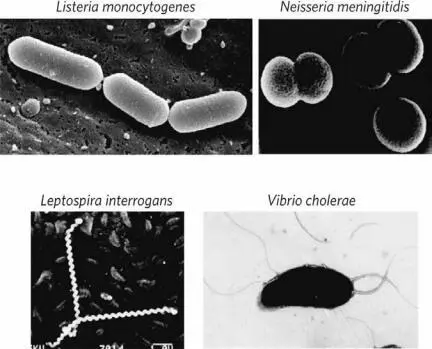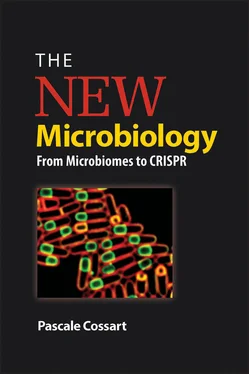Figure 1. The three large domains of life. Bacteria, Archaea , and Eukaryota have a common ancestor.
Bacteria are extremely varied and make up the most diverse domain of life. They have been on Earth for billions of years and have evolved to survive in a great variety of conditions. There are more than 11,500 known species of bacteria in more than 2,000 genera (groupings of species). These numbers have so far been based only on gene comparisons, particularly the 16S RNA genes, and they keep rising. Classification methods are changing too. Now that we can compare entire genome sequences, the definition of “species” itself is evolving.
Bacteria may have different shapes ( Fig. 2). There are four main categories: cocci, or spheres; bacilli, or rods; spirals; and comma-shaped, or curved bacteria. All bacteria divide, regardless of their shape. One bacterium splits into two, via an asexual reproduction. Nevertheless, genetic material can be exchanged between two bacteria by means of mechanisms described as horizontal gene transfer . We will come back to this topic later on.
Bacteria are present everywhere in the environment; they are in all habitats on earth, including hot springs and seawater, even in very high salinity. Many live in humans—there are an estimated 10 10bacteria on our skin, 10 10in our mouths, and 10 14in our intestines. That’s 10 times more bacterial cells in our bodies than human cells! However, a recently published article investigated this number and concluded that it was actually overestimated by a factor of 10. Whatever the count, in our intestine—which contains tens of billions of bacteria—there are more than a thousand different species. Sometimes I like to think that bacteria are our constant companions, generally friendly hitchhikers that we carry around with us everywhere!

Figure 2. The four main types of bacteria: bacilli (Listeria monocytogenes) , cocci (Neisseria meningitidis or meningococci), spirals ( Leptospira interrogans ), and comma-shaped ( Vibrio cholerae ).
Bacteria first appeared more than 3 billion years ago—that’s 2 billion years before animals—and have since lived more or less undisturbed in the biosphere. We do not know for sure how the first organism with a nucleus was born, but it was probably from the fusion of a bacterium with an archaeon. Indeed, genes from both of these domains are present in animals; it is clear that an ancestor of all modern eukaryotes must have “swallowed” a bacterium, leading to the stable symbiotic relationship that produced the energy-producing compartments called mitochondria in all of our cells. These small organelles somewhat resemble bacteria and are indispensable to the formation of thousands of compounds, most notably ATP, a chemical compound that temporarily stores energy and is used for many chemical reactions in cells. One could say that the first animals started out as bacterivores before they became herbivores, carnivores, or omnivores!
Many bacteria live free in natural environments. There they live, grow, and feed and by doing so contribute to the equilibrium and characteristics of the specific ecosystems in which they grow. For example, bacteria from the Streptomyces family are responsible for the so refreshing smell of the woods after a rain.
Many other bacteria are not alone and are associated with a partner. They establish long-lasting relationships that are mutually beneficial, or “symbiotic,” within humans, animals, and even plants. Additionally, as we will soon see, bacteria of several species can assemble in very large communities, called microbiomes , which become integral part of organisms. These combinations of organisms and microbiomes are referred to as superorganisms .
It is important to realize that of all the bacteria on Earth, pathogenic bacteria (those responsible for disease) are in the minority. Among those, a few produce very powerful toxins and always induce disease. An example is Vibrio cholerae , the water-transmissible Vibrio species responsible for cholera, which produces a toxin that can cause fatal diarrhea and dehydration. Another example is Corynebacterium diphtheriae , which causes diphtheria, a disease nearly forgotten in developed countries due to the efficacy of mandatory vaccinations. Also in this group is Clostridium tetani , which produces the toxin for tetanus, and Clostridium botulinum , which produces the botulinum toxin.
However, illnesses caused by a single toxin are extremely rare. As a general rule, bacteria create disease by means of an arsenal of strategies and tools called virulence mechanisms and virulence factors . The combination of different virulence factors allows a bacterium to enter an organism, evade the host’s defense mechanisms, and multiply and invade different parts of the body such as the throat (Streptococcus) , the lungs (Legionella) , the intestines (Salmonella) , or the nose and pharynx (Pneumococcus) . Bacteria often can establish an infection only if the host’s immunity is weakened by fatigue by a viral or other infection (such as pneumococcal infections that often follow respiratory tract inflammation due to influenza), by medical treatment (such as immune suppression due to chemotherapy), or by a genetic mutation.
The importance of the genetic context with regard to a host’s susceptibility to infection is now the subject of extensive studies by scientists around the world. The laboratory led by Jean-Laurent Casanova is a strong proponent of the hypothesis that disease can be or is linked to the host’s genetics. These investigators have found evidence for genetic predisposition to several illnesses, for example, susceptibility to infection with low-pathogenicity mycobacterial strains including BCG, the live attenuated strain of Mycobacterium bovis used to vaccinate against tuberculosis. Some children have a defect in one of the genes coding for interferon or for interferon signaling, which can result in unanticipated and sometimes fatal illness after vaccination.
Throughout this book, we will learn that bacteria, both pathogenic and nonpathogenic, are living organisms with a range of diverse properties, some of which are quite unexpected. With their unique capacity to produce vital compounds or to transform or eliminate other compounds, bacteria contribute constantly to the everyday lives of their hosts and to the balance of the ecosystems where they live.
CHAPTER 2
Bacteria: Highly Organized Unicellular Organisms
Bacteria seem to be very simple cells, having neither a nucleus nor internal organelles as in animal or plant cells, but they actually have a highly structured internal organization. Their shape is very precise and their content is well organized. Each protein or group of proteins has its specific location, from one generation to the next.
Most bacteria have an outer layer consisting of a thin membrane that is covered by a cell wall made up of pep-tidoglycan , which gives each bacterium its shape and rigidity and allows it to survive drastic differences between its interior and its exterior environment, including differences in temperature, pH, and salinity. Some bacteria also have a second external membrane and also a capsule.
Bacteria are often classified into two categories, Gram positive and Gram negative. These terms derive from the staining technique developed by Hans Christian Gram, in which a purple dye binds to the pep-tidoglycan in bacteria that have a thick cell wall but no external membranes and is negative in all other cases. The Gram stain uses crystal violet, a purple stain that binds to the peptidoglycan in bacterial cell walls. The process concludes with a wash with a decolorizing agent and counterstain. Bacteria that have cell walls but no external membranes retain the stain (yielding a purple-colored “positive” cell) while bacteria with external membranes and a thinner cell wall do not retain the crystal violet (yielding pink-colored “negative” cells).
Читать дальше












